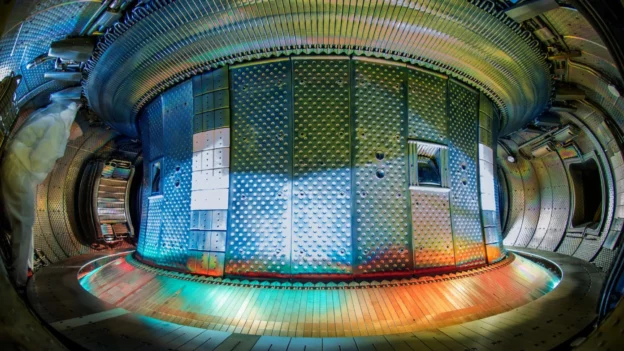In France, a tungsten-coated Tokamak has set a new nuclear fusion record in handling fusion plasma, after effectively containing its reaction thanks to this highly heat-resistant metal. This advance allows physicists to operate with plasmas at higher temperatures and densities, relative to previous models that used carbon.
New nuclear fusion record
This device has a toroid shape and uses magnetic fields to confine the plasma, making it easier to manipulate the extremely hot material and promoting fusion reactions. The achievement was achieved in the WEST ( Tungsten Environment in Steady-state Tokamak ), a tokamak that operates under the aegis of the French Commission for Alternative Energies and Atomic Energy ( CEA ).
In a recent test, WEST received an injection of 1.15 gigajoules of energy and managed to maintain a plasma of approximately 50 million degrees Celsius for six minutes. This record was achieved after scientists decided to coat the inside of the tokamak with tungsten, known for its high melting point. During the experiment, researchers at the Princeton Plasma Physics Laboratory used an X-ray detector to analyze and record the behavior of the plasma and the conditions necessary to achieve this result.
“ These results are exceptional ,” said Xavier Litaudon of the CEA, adding that a steady state was achieved under challenging conditions, driven by the tungsten coating of the reactor. This underlines the potential of nuclear fusion , a process where atoms combine to release energy, contrasting with nuclear fission which splits them and generates dangerous waste. Nuclear fusion is emerging as a clean and potentially unlimited energy alternative.
The global influence after implementation of tungsten
Recently, the Korea Fusion Energy Institute also adopted tungsten in its KSTAR tokamak , replacing the previous carbon diverter. According to the National Science and Technology Research Council of Korea , the new tungsten diverter has doubled the reactor’s ability to handle heat flow, allowing ion temperatures in excess of 100 million degrees Celsius to be sustained for extended periods.

A demonstration of the WEST. Source: CEA IRFM.
Principal scientist at PPPL, Luis Delgado-Aparicio, detailed: “ The challenge of working with a tungsten wall is significantly greater than with carbon .” Additionally, he compared the difference in handling these conditions to variation, such as having a domestic cat and trying to touch a wild lion.
Follow us on social networks and don’t miss any of our publications!
Inspenet.com YouTube LinkedIn Facebook Instagram X
Source and photo: PPPL

